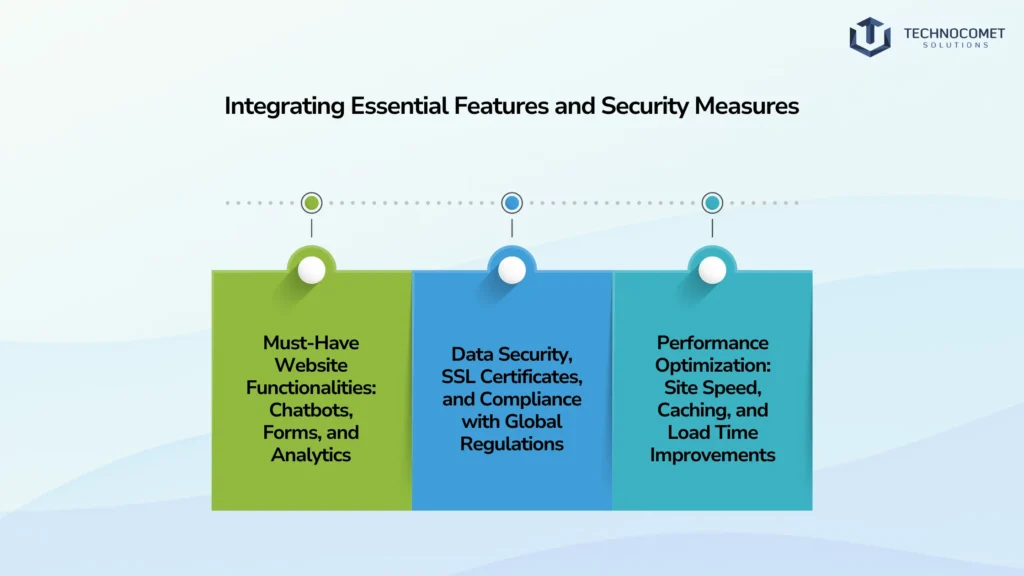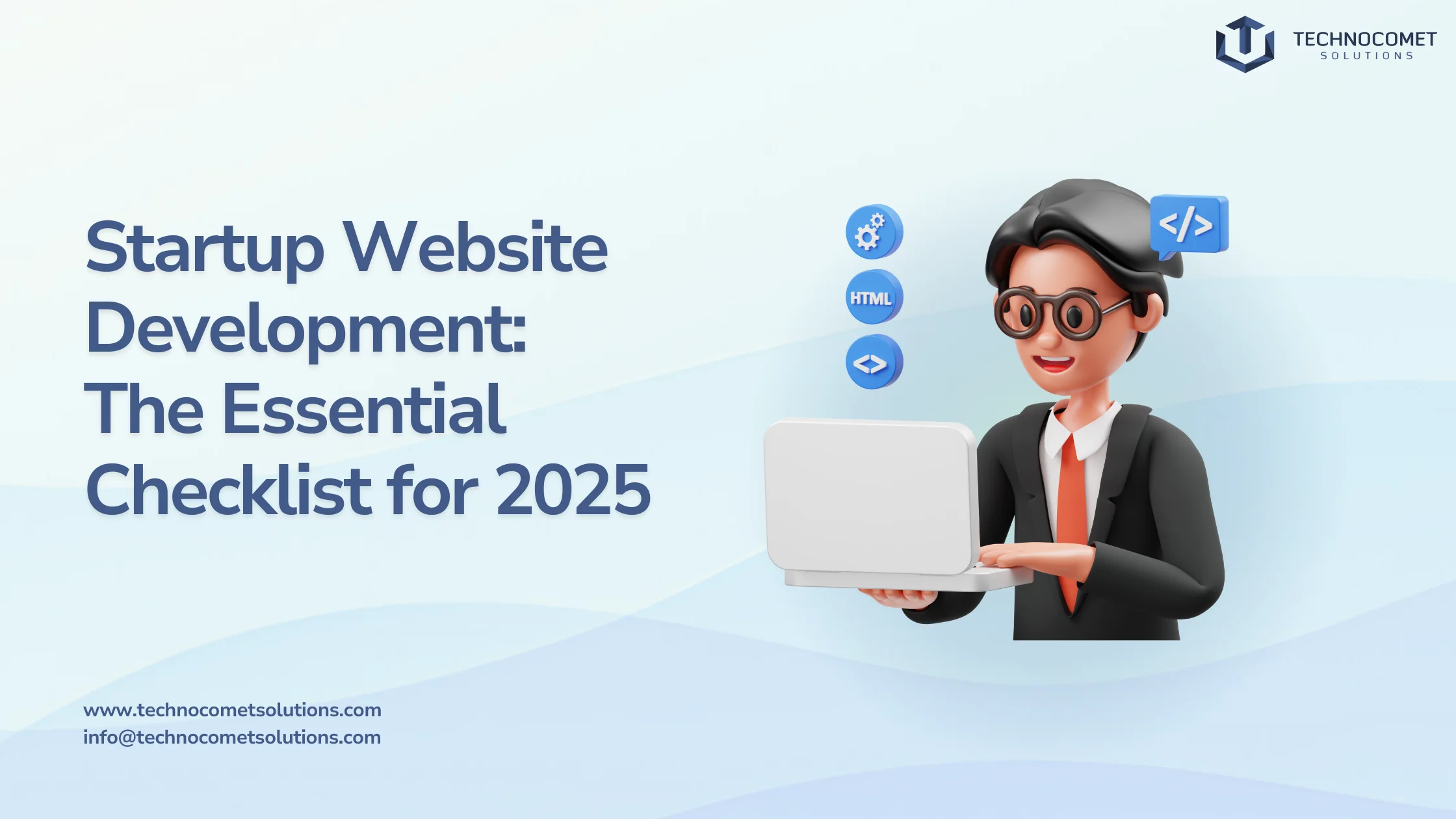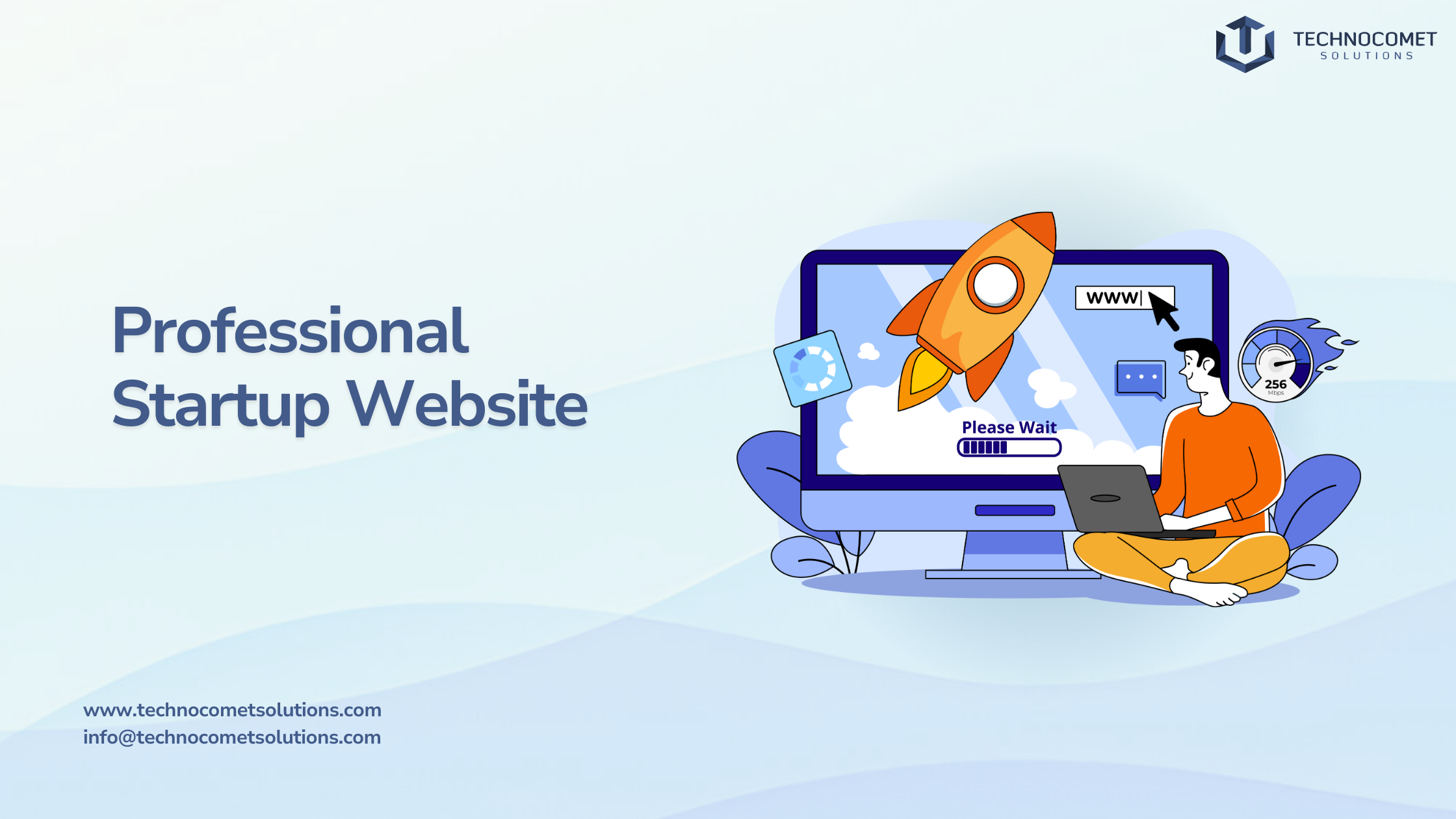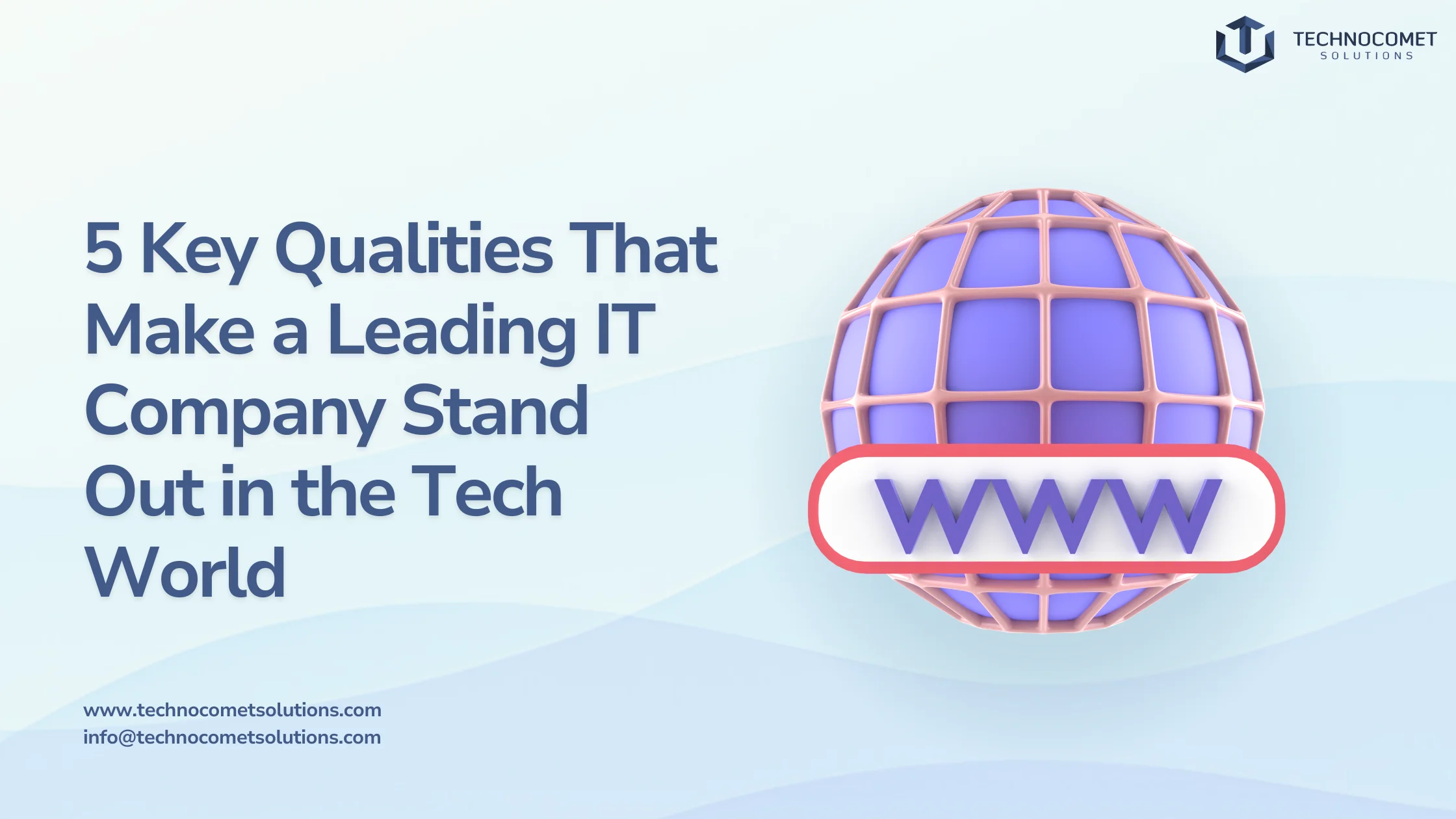Introduction
In 2025, a well-structured website is no longer a luxury but a necessity for startup success. It serves as the digital face of your business, providing potential customers with their first impression of your brand. A strategic development checklist is crucial for ensuring that your website aligns with your business objectives, setting the stage for long-term growth. Technocomet Solutions emphasizes the importance of defining clear website goals, identifying your target audience, and selecting the right technology and hosting services. A well-designed website enhances credibility, increases visibility, and drives customer engagement, making it a vital tool for any startup. By investing in startup website development, you can establish a strong online presence that sets your business apart from competitors. Effective startup website development involves careful planning and ongoing optimization to ensure that your site remains competitive and supports your business goals.
In today’s digital landscape, having a professional website is essential for reaching a wider audience and staying ahead of the competition. A well-structured website is the foundation of a successful online strategy, providing 24/7 accessibility and global reach. By prioritizing startup website development, you can create a powerful platform that drives business growth and success.
The Importance of a Well-Structured Website for Startup Success in 2025
A well-structured website is crucial for startup success in 2025. It not only establishes your online presence but also plays a critical role in branding, lead generation, and sales. According to Pew Research, 81% of customers research online before making a purchase, highlighting the importance of having a professional website to attract and retain customers. A well-designed website enhances credibility, increases visibility, and drives customer engagement, making it a vital tool for any startup. By investing in startup website development, you can create a platform that supports your business goals and drives long-term success. Moreover, a well-structured website helps you establish a strong brand identity, which is essential for differentiating your business in a crowded market.
This involves creating consistent branding across all pages, using a clear and compelling brand voice, and ensuring that your website reflects your brand’s values and mission. This involves optimizing your site for mobile devices, ensuring fast loading times, and simplifying navigation to guide users through the user journey effectively. By focusing on these aspects, you can create a website that not only attracts visitors but also retains them, fostering loyalty and driving business growth through effective startup website development.
How a Strategic Development Checklist Ensures Long-Term Growth
A strategic development checklist is essential for ensuring long-term growth in startup website development. This checklist helps you align your website with your business objectives, ensuring that every aspect of your site supports your overall strategy. It involves defining clear goals, selecting the right technology, prioritizing user experience, and implementing SEO strategies. By following a strategic checklist, you can create a website that not only attracts visitors but also converts them into loyal customers, fostering long-term growth and success. Moreover, a strategic checklist ensures that you stay focused on key performance indicators (KPIs) such as traffic, engagement, and conversion rates.
Additionally, a strategic checklist helps you plan for scalability, ensuring that your website can handle increased traffic and user demands as your business grows. This might involve investing in scalable hosting solutions, developing a content strategy that can adapt to changing audience needs, and staying informed about the latest web development trends. By adopting a proactive approach to startup website development, you can ensure that your website remains a powerful tool for driving business success.
Key Factors Every Startup Must Consider Before Launching a Website
Before launching a website, startups must consider several key factors. These include defining clear website goals, identifying your target audience, and selecting the right technology and hosting services. Understanding your audience’s demographics, interests, and online behaviors helps tailor your content and user experience to meet their needs. Additionally, choosing between custom development, CMS platforms, and website builders depends on your technical expertise, budget, and scaleability needs. By carefully considering these factors, you can create a website that resonates with your audience and supports your business goals through effective startup website development.
This involves designing for smaller screens, ensuring fast loading times, and simplifying navigation to improve user engagement and support your startup website development strategy. Furthermore, integrating essential features like chatbots, forms, and analytics tools can enhance user engagement and provide valuable insights to inform your startup website development strategy. By focusing on these key factors and staying committed to ongoing optimization, you can ensure that your website remains competitive and drives business growth.

Defining Clear Website Goals and Audience
Understanding the Purpose of Your Website
Your website’s purpose can be multifaceted, but it’s essential to prioritize its primary function. Whether it’s to build your brand, generate leads, or facilitate sales, this purpose will influence every aspect of your startup website development. For instance, if your focus is on sales, you’ll want to ensure that your website is optimized for conversions with clear calls-to-action and streamlined checkout processes. This might involve integrating features like product recommendations, customer reviews, and secure payment options to enhance the shopping experience.
Moreover, understanding your website’s purpose helps you allocate resources effectively. If branding is your priority, you might focus on creating engaging content and visual elements that reflect your brand identity. This could include developing a strong brand voice, using consistent branding across all pages, and creating interactive experiences that showcase your brand’s personality.
Identifying Your Ideal Audience
Understanding your audience is crucial for effective startup website development. Knowing their demographics, interests, and online behaviors helps you tailor your content, design, and user experience to meet their needs. This involves creating user personas to guide your design decisions and ensure that your website resonates with your target audience. For example, if your audience is predominantly young adults, you might focus on creating a modern, mobile-friendly design with content that addresses their specific interests and concerns.
Additionally, identifying your audience helps you develop targeted marketing strategies. By understanding how your audience interacts with your website, you can optimize your site’s structure and navigation to guide them through the user journey effectively. This might involve using analytics tools to track user behavior and adjust your content and design accordingly.
Aligning Website Features with Business Objectives
Aligning your website features with your business objectives is vital for maximizing impact. This means ensuring that every element of your site, from its design to its functionality, supports your overall business strategy. For example, if your goal is lead generation, you might focus on creating compelling landing pages and integrating lead capture forms throughout your site. This could also involve using A/B testing to optimize your forms and improve conversion rates.
This might involve conducting user feedback sessions, analyzing performance metrics, and making adjustments to improve user engagement and conversion rates. By continuously optimizing your site, you can ensure that it remains a powerful tool for achieving your business goals through effective startup website development.
Selecting the Right Technology and Hosting
Choosing Between Custom Development, CMS Platforms, and Website Builders
When it comes to startup website development, choosing the right technology is crucial. You have three main options: custom development, CMS platforms like WordPress, and website builders like Wix or Squarespace. Each option has its pros and cons, and the choice depends on your technical expertise, budget, and scalability needs. Custom development offers flexibility but requires more resources, while CMS platforms provide ease of use and extensive community support. Website builders are ideal for those with limited technical knowledge, offering drag-and-drop functionality and quick setup.
For instance, if you’re looking for a high degree of customization and control over your website’s design and functionality, custom development might be the best choice. However, if you’re on a tight budget or need to launch your site quickly, a CMS platform or website builder could be more suitable. Understanding these options and their implications for your startup website development is essential for making an informed decision.
The Importance of Fast, Secure, and Scalable Hosting Services
Fast, secure, and scalable hosting is essential for any startup website. Slow loading times can deter visitors, while security breaches can damage your reputation. Look for hosting services that offer robust security features, reliable uptime, and the ability to scale as your traffic grows. This ensures that your website remains accessible and secure, supporting your startup website development efforts. Moreover, choosing the right hosting service involves considering factors like server location, bandwidth, and customer support.
A hosting service with servers located near your target audience can improve loading times, while robust customer support ensures that any issues are resolved quickly. By prioritizing these aspects, you can ensure that your website provides a seamless user experience and remains competitive in the digital landscape.
Ensuring Compatibility with Future Tech Trends and Updates
As technology evolves, it’s important to ensure that your website remains compatible with future trends and updates. This involves choosing platforms and technologies that are adaptable and regularly updated to keep pace with the latest developments in web design and functionality. For example, ensuring that your site is optimized for voice search or integrating AI-powered chatbots can enhance the user experience and keep your site ahead of the curve. Furthermore, staying informed about emerging trends in web development allows you to plan for future updates and enhancements.
This might involve attending industry conferences, following tech blogs, or participating in developer communities to stay updated on the latest tools and technologies. By adopting a forward-thinking approach to startup website development, you can ensure that your website remains relevant and competitive over time.
Prioritizing User Experience and Mobile-First Design
Why Intuitive UI/UX is Crucial for Startup Website Success
Intuitive UI/UX is vital for startup website success. A well-designed user interface ensures that visitors can easily navigate your site, find what they’re looking for, and complete desired actions. This enhances user engagement and conversion rates, making it a key aspect of startup website development. A user-friendly interface involves creating clear and concise menus, using prominent calls-to-action, and ensuring that every page serves a purpose in the user journey.
Moreover, intuitive UI/UX involves understanding how users interact with your site. This might involve conducting usability tests to identify areas for improvement and using feedback to refine your design. By prioritizing user experience, you can create a website that not only attracts visitors but also retains them, fostering loyalty and driving business growth through effective startup website development.
Mobile-First Design Principles and the Impact on User Engagement
Mobile-first design is no longer optional; it’s essential. Most users access websites via mobile devices, so your site must be optimized for mobile to ensure a seamless user experience. This involves designing for smaller screens, ensuring fast loading times, and simplifying navigation to improve user engagement and support your startup website development strategy. Additionally, mobile-first design requires considering the unique challenges of mobile devices, such as limited screen space and touch-based interactions.
This might involve using responsive design techniques to ensure that your site adapts smoothly to different screen sizes and orientations. By prioritizing mobile-first design, you can ensure that your website provides a consistent and engaging experience across all devices.
Optimizing Site Structure, Navigation, and Call-to-Action Elements
Optimizing your site’s structure, navigation, and call-to-action elements is crucial for guiding users through your website effectively. This involves creating clear and concise menus, using prominent calls-to-action, and ensuring that every page serves a purpose in the user journey. These elements are critical for effective startup website development. Furthermore, optimizing these elements involves using data-driven insights to inform your design decisions.
This might involve analyzing user behavior through analytics tools to identify bottlenecks in the user journey and making adjustments to improve navigation and conversion rates. By continuously refining your site’s structure and navigation, you can enhance the user experience and drive more conversions.
Implementing SEO and Content Strategies for Visibility
Conducting Keyword Research and On-Page SEO Optimization
SEO is a cornerstone of startup website development. Conducting thorough keyword research helps you understand what your audience is searching for, allowing you to optimize your content accordingly. On-page SEO optimization involves using these keywords strategically in your titles, descriptions, and headings to improve search engine rankings.
Moreover, on-page SEO involves optimizing other elements like meta tags, alt text for images, and internal linking to enhance your site’s visibility. This requires staying updated on the latest SEO best practices and using tools like Google Analytics to track your site’s performance and adjust your strategy accordingly.
Content Marketing Strategies: Blogs, Case Studies, and Media
Content marketing is a powerful tool for attracting and engaging your audience. Strategies include maintaining a blog for insights and updates, publishing case studies to demonstrate expertise, and using multimedia content like videos and podcasts to diversify your offerings. These strategies enhance your brand’s authority and visibility, supporting your startup website development efforts. Additionally, content marketing involves creating a content calendar to ensure consistency and planning.
This might involve collaborating with influencers, guest blogging on other sites, and repurposing content across different channels to maximize reach. By developing a robust content strategy, you can attract and retain a clearly defined audience and drive profitable customer action.
Leveraging Local and Technical SEO for Better Search Rankings
Leveraging local and technical SEO can further boost your search rankings. Local SEO involves optimizing your site for location-specific searches, which is crucial for businesses with physical locations. This might involve creating a Google My Business listing using location-specific keywords and ensuring that your site is listed in local directories. Technical SEO focuses on improving site speed, mobile responsiveness, and other technical aspects that search engines consider when ranking websites.
This involves optimizing images, using caching to reduce load times, and ensuring that your site is secure with an SSL certificate. Both local and technical SEO are essential for maximizing your online visibility in startup website development.

Integrating Essential Features and Security Measures
Must-Have Website Functionalities: Chatbots, Forms, and Analytics
Certain functionalities are must-haves for any startup website. These include chatbots for customer support, forms for lead capture, and analytics tools to track user behavior and site performance. These features enhance user engagement and provide valuable insights to inform your startup website development strategy.
Moreover, integrating these features requires careful consideration of user experience. For example, chatbots should be designed to provide quick and relevant responses, while forms should be simple and easy to fill out. Analytics tools help you understand how users interact with your site, allowing you to make data-driven decisions to improve performance.
Data Security, SSL Certificates, and Compliance with Global Regulations
Data security is paramount. Installing SSL certificates ensures that your site is secure, which is crucial for building trust with your audience. Additionally, complying with global regulations like GDPR and CCPA is essential to avoid legal issues and protect user data. These measures are critical for maintaining a secure and compliant website in startup website development.
Furthermore, ensuring data security involves implementing robust security protocols, such as regular backups, secure password policies, and two-factor authentication. Staying informed about the latest security threats and updates is also important to ensure that your site remains protected.
Performance Optimization: Site Speed, Caching, and Load Time Improvements
Optimizing your site’s performance is vital for the user experience and search engine rankings. Techniques include improving site speed, using caching to reduce load times, and optimizing images to ensure that your site loads quickly on all devices. These optimizations are key to ensuring that your website remains competitive in the realm of startup website development.
Additionally, performance optimization involves regularly monitoring your site’s performance and making adjustments as needed. This might involve using tools like Google PageSpeed Insights to identify areas for improvement and implementing solutions like content delivery networks (CDNs) to enhance site speed.
Testing, Launching, and Continuous Optimization
Pre-Launch Testing: Bug Fixes, Usability Checks, and Responsiveness Testing
Before launching your website, thorough testing is essential. This includes fixing bugs, conducting usability checks to ensure that your site is intuitive, and testing responsiveness across different devices. These steps ensure that your website is ready for launch and support your startup website development goals.
Moreover, pre-launch testing involves testing for accessibility to ensure that your site is usable by everyone, including those with disabilities. This might involve using tools like WAVE to identify accessibility issues and make adjustments to improve usability.
Post-Launch Strategies: Monitoring Performance and User Feedback
After launch, it’s crucial to monitor your website’s performance and gather user feedback. This involves tracking metrics like traffic, engagement, and conversion rates, as well as collecting feedback through surveys or comments. This data helps you identify areas for improvement and inform future updates in startup website development.
Additionally, post-launch strategies involve staying agile and responsive to user needs. This might involve conducting A/B testing to optimize elements like calls-to-action or forms and using user feedback to refine your content and design. By continuously listening to your audience and adapting to their needs, you can ensure that your website remains relevant and effective.
Regular Updates, Feature Enhancements, and Scaling for Growth
Finally, startup website development is an ongoing process. Regular updates and feature enhancements keep your site fresh and competitive. As your business grows, your website must scale to meet increasing traffic and user demands. This involves continuously optimizing performance, adding new features, and adapting to emerging trends in web design and technology. Moreover, scaling for growth requires planning ahead.
This might involve investing in scalable hosting solutions, developing a content strategy that can adapt to changing audience needs, and staying informed about the latest web development trends. By adopting a proactive approach to startup website development, you can ensure that your website remains a powerful tool for driving business success.
Conclusion
In conclusion, startup website development is a multifaceted process that requires careful planning, strategic execution, and ongoing optimization. By understanding your website’s purpose, identifying your audience, selecting the right technology, prioritizing the user experience, implementing SEO strategies, integrating essential features, and continuously optimizing your site, you can create a powerful online presence that supports your business goals and drives long-term success. Whether you’re focusing on branding, lead generation, or sales, a well-developed website is the cornerstone of any successful startup in 2025. By following these guidelines and staying committed to startup website development, you can ensure that your business remains competitive and thrives in the digital landscape. Moreover, the importance of startup website development cannot be overstated. It’s not just about creating a website; it’s about building a platform that represents your brand, engages your audience, and drives business growth.
Ready to elevate your startup’s online presence? Contact TechnoComet Solutions today to explore how our expert IT services can support your startup website development journey. Contact us today!
FAQs
A successful startup website development strategy involves defining clear website goals, identifying your target audience, and selecting the right technology and hosting services. It also includes prioritizing user experience, implementing SEO strategies, and integrating essential features like chatbots and analytics tools.
Mobile-first design is crucial for startup website development, as most users access websites via mobile devices. It involves designing for smaller screens, ensuring fast loading times, and simplifying navigation to improve user engagement.
SEO plays a vital role in startup website development by enhancing your website’s visibility in search engine results. This involves conducting keyword research, optimizing on-page elements, and leveraging local and technical SEO strategies. By improving your search rankings, you can increase traffic, drive more leads, and support your business growth objectives.
To ensure your startup website remains competitive and secure, focus on ongoing optimization and security measures. Additionally, consider partnering with experts who can provide guidance and support in startup website development to ensure your site stays ahead of the competition.







